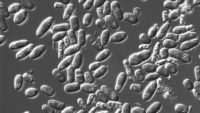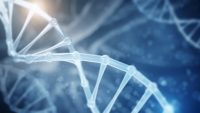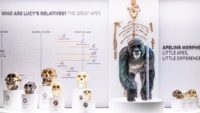It is hard to identify the behavior of creatures just from their fossils. An international team of paleontologists tried just that on a big group of dinosaur fossils from Argentina. Their Mussaurus specimens included developmental stages from egg through juveniles to adults. Clues from the 100 eggs and 80 specimens suggested to this team that these dinosaurs had social behaviors. A look at the traits behind these behaviors reveals a crea… More… …read more Source: icr.org
Natural selection can only select for the attributes an organism needs to survive, so how is it that creatures are endowed with a whole lot more than necessary? …read more Source: creation.com
The bacterium has “remarkable” and “sophisticated” nano-scale electric motors …read more Source: creation.com
What does it tell us about the evolution of flight? …read more Source: creation.com
By Dr. Alan L. Gillen Just as the baker uses yeasts to transform hard, flat dough into new bursting life in bread and beverages, the Creator makes new living creatures in Christ. …read more Source: AIG Daily
By Ken Ham “Shocking human tail surgically removed from newborn,” the headlines proclaimed. According to news reports, a baby boy was recently born in Brazil with a “human tail with a ball at the end of it.” The report even went so far as to call this a “real human tail”—but is that what it really is? Well, the article states (note how evolutionary the terminology sounds—really, what they call a “tail” isn’t a tail at all but the critically important coccyx where the muscles will attach later in development): Around the fourth week of gestation, most of us start [More]
By Dr. Elizabeth Mitchell If all the ingredients necessary for life can occur naturally, does that mean over time they can evolve into a living creature? …read more Source: AIG Daily
The sprouting of a seed is crucial to not only the beginning of a plant’s life, but all life on earth. Despite this fundamental process of importance to plant biology, scientists are baffled over how seeds detect when there’s enough water to germinate. This mystery is now beginning to unfold and nothing less than finely tuned engineering is the clear result. Researchers recently reported the discovery of a special… More… …read more Source: icr.org
The book of Proverbs states, “Go to the ant, you sluggard! Consider her ways and be wise” (6:6). Evolutionists went to the ant, not to learn of her God-given ability to gather and store provisions, but to vainly attempt to determine human brain evolution. Human brain size has decreased since 3,000 years ago and is a mystery to anthropologists. To disentangle this mystery, a team of res… More… …read more Source: icr.org
By Eric Cassell On today’s ID the Future, Animal Algorithms author Eric Cassell delves into another fascinating portion of his new book, the programmed social behaviors of colony insects and the challenge these instinctive behaviors pose for modern evolutionary theory. Cassell and host Robert J. Marks discuss the complex caste system of these colonies, the impressive signaling systems they use to communicate, and how technologists study these tiny-brained creatures to learn tricks for developing and improving drone swarm technology. How could a mindless evolutionary process have evolved these sophisticated colonies, where various castes appear essential to the functioning and survival [More]
Dramatic reductions in fish size disappoint anglers and surprise many evolutionists …read more Source: creation.com
By Ken Ham What’s the driving force of evolution? Ask that question to your average evolutionist and they will respond with “natural selection.” Well, a new study says “evolution is also influenced by tangles in the DNA strands.” It appears that these DNA “tangles” make it much more likely that a mutation will occur, thus supposedly driving evolution. But is that what is taking place? Well, mutations are not examples of evolution. They are mistakes in already-existing genetic sequences and are generally either harmful or neutral, although a select few give a survival advantage in a restricted environment. But if [More]
Since the famous ape skeleton dubbed Lucy was discovered in 1974, researchers have debated how much time she spent in trees. …read more Source: AIG Daily
Animal migrations occur all over the earth among many types of creatures, with some winged creatures (birds and insects) making the most extreme and lengthy ones. Among insects, the globe skimmer dragonfly (Pantala flavescens) is exceptional—being able to fly up to 3,730 miles across the open ocean. Scientists are finally beginning to unravel the required specificity behind the anatomical, behavioral, and metabolic complexity that … More… …read more Source: icr.org
A key design feature of modern golf balls has been found on sharks, too. …read more Source: creation.com
By Harry F. Sanders, III Carnegie Museum biologist suggests a new evolutionary history for snails and slugs but fails to account for differences in anatomy and lack of evidence. …read more Source: AIG Daily
When researchers found that a rainforest fly was unable to adapt to drier conditions, it was ‘a complete surprise’. But why? …read more Source: creation.com
By Ken Ham For decades 98% of DNA was considered to be “junk DNA”—useless leftovers from our supposed evolutionary history. This view has held scientific research back as many evolutionists don’t even bother to research the non-coding “junk” regions—but are these days “over”? A new paper on the platyhelminth worm, Schistosoma mansoni, was published recently in the journal Genome Biology and Evolution. This study looked at repetitive DNA on the female W-chromosome, and they discovered that so-called “junk DNA” portions are involved in sex determination. The study authors write: The days of “junk DNA” are over. When the senior authors [More]
A powerful cumulative case against abiogenesis. …read more Source: creation.com
By Ken Ham One start-up has a lofty goal—to “resurrect” the woolly mammoth by 2027 . . . sort of. You see, if successful, it will not be a true woolly mammoth like those that lived during the post-flood ice age but, rather, a modern elephant with edited genes (thanks to the “molecular scissors” technology CRISPR)—giving it smaller ears, more body fat, and the ability to survive the cold Arctic tundra. The company hopes that their hybrids will start having calves within four to six years and that artificial wombs will eventually help bolster large-scale herds to roam an area [More]
The ‘great apes’ are not-so-great at providing clues as to our origins …read more Source: creation.com
Skeptics scoff at the long lifespans of the biblical Patriarchs. Yet, the biblical data gives us a seamless exponential decay curve that could not have been invented by accident. …read more Source: creation.com
Has preserved skin, blood vessels, and bone cells …read more Source: creation.com
By Ken Ham Yes! “Ancient” crocodiles did eat plants! How do we know this? Well, scientists conducted a detailed analysis of 146 tooth fossils from sixteen crocodyliforms (“members of the crocodile and alligator family”) and determined that between three and six were herbivores—but that’s not how we know for sure. More on that in a moment. First, I want to highlight a quote from the study author: The most interesting thing we discovered was how frequently it seems extinct crocodyliforms ate plants . . . Our study indicates that complexly-shaped teeth, which we infer to indicate herbivory, appear in the [More]
White squirrels appear in a handful of towns in North America. How did they get there? Is it evolution? Is white fur a beneficial mutation or a curse? …read more Source: creation.com
A novel genetic paradigm for how the created kinds diversified after the Flood Read More
What is brood parasitism? Can evolution explain its origin? …read more Source: creation.com









































